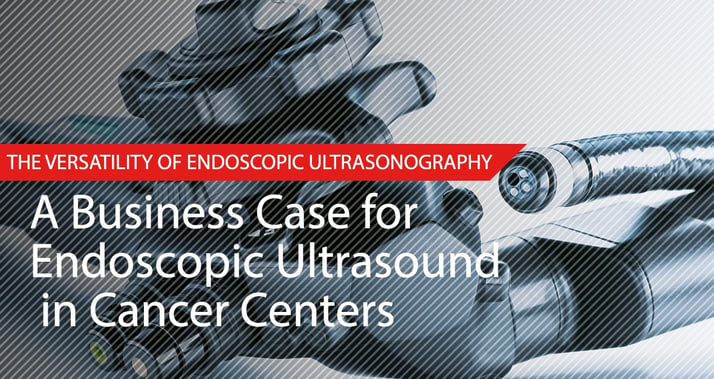
The Centers of Medicare and Medicaid Services (CMS) is gradually lowering the reimbursement rate for diagnostic procedures in gastroenterology and other specialty areas of medicine. Private payers often follow suit. This means that many healthcare facilities, and particularly cancer centers, are thinking carefully before they purchase certain diagnostic equipment.
If cancer centers look at Endoscopic Ultrasonography (EUS) as just another diagnostic tool for gastroenterologists, at first it seems not to make good business sense to invest in the ultrasound gastroscope. It is often thought that the expense of the equipment and training combined with low reimbursement rates for EUS don’t add up to a worthwhile investment. However, there are several features and a great deal of business potential for EUS that cancer centers may not taking into consideration, including the versatility of the equipment, the value in cancer care, and the downstream revenue that can be generated.
EUS caters to both diagnostics and therapeutics in oncology. As a diagnostic, EUS is often used to evaluate known abnormalities, including lumps or lesions, which were detected with prior endoscopy or with CT scans. EUS can offer detailed images of these lumps or lesions to aid in diagnosis. For certain digestive and respiratory cancers, EUS can help oncologists determine the extent of metastases, assess the cancer’s depth, and even obtain more clinically appropriate biopsies.1
Altogether, the cost savings of using non-invasive procedures, the versatility of the equipment, and the broad range of oncology uses may be enough to offset the equipment costs and reduced reimbursement rates. Another business consideration that can add to these monetary advantages is downstream revenue. Consider that even for cancer centers that don’t specialize in gastroenterology (GI) oncology, a large number of cases are GI cancers. Pancreatic cancer is one of the top 10 cancers diagnosed in the US, with about 46,000 cases diagnosed each year. Among other cancers with a high diagnosis rate are: liver cancer diagnoses with 33,000 each year, gastric cancer 22,000 each year, and colon cancer with 145,000 each year.2 A patient with one of these cancers is most likely to seek out a healthcare facility or cancer center with the specialized equipment needed for state-of-the-art diagnostic and therapeutic care. A medical center without an ultrasound gastroscope is potentially missing out on the revenue stream of that patient not only for their first procedure, but quite possibly for any follow up care, including biopsies, chemotherapy, radiation, yearly follow ups, and so on. In conclusion, the missed revenue from just one patient could be substantial.
More than ever, healthcare systems and providers need to think strategically when considering which specific equipment fit their needs, what offers substantial payoff, and return on investment. Specialized equipment such as an ultrasound gastroscope is one area that deserves careful consideration, especially for dedicated cancer centers or hospitals with oncology departments. While the initial investment cost may seem daunting, healthcare leaders can benefit from considering the long-term value of EUS equipment rather than focusing on only near-term business goals.
References:
1. http://www.asge.org/patients/patients.aspx?id=380
2. http://cancer.osu.edu/cancer-specialties/cancer-care-and-treatment/gastrointestinal-cancers
